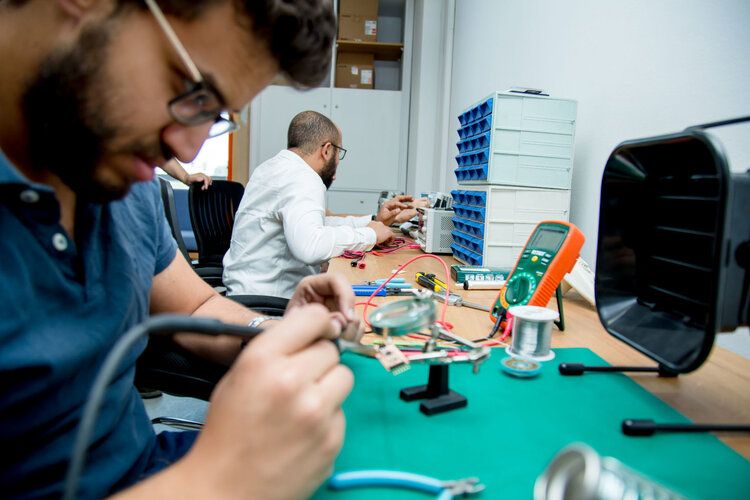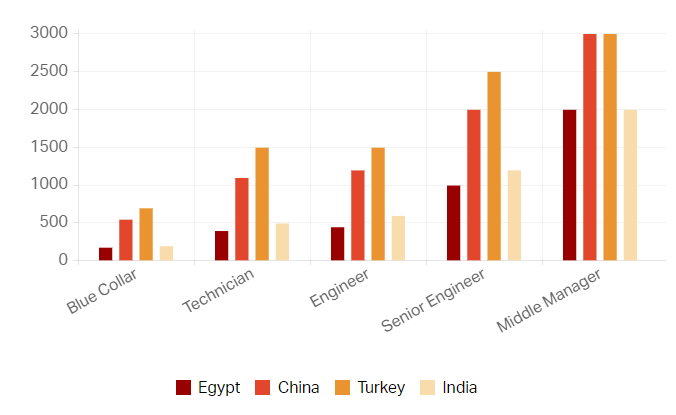Hardware Things is managed by Chuma Asuzu through the support of generous sponsors.
The published features on this site are licensed CC BY-SA 4.0, unless otherwise stated.
Rawnaa Al-Masry
Since its establishment in 2005, the Information Technology and Industry Development Agency (ITIDA) under the Ministry of Communication and Information Technology (MCIT) has had one core mission: to spearhead the development of Egypt’s ICT industry in a bid to increase its global competitiveness. As part of this mission, the agency launched the ambitious Egypt Makes Electronics (EME) initiative supported by the country’s president in 2015. The initiative aims to position Egypt as the regional hub for electronics manufacturing and a global destination of choice for electronics design and innovation.
About the same time, Ahmed Sobhy was completing his Bachelors in Mechatronics Engineering at the October 6 University in Cairo. For his graduation project, he was exploring the control of home devices using the Internet of Things. “In the US, you can easily find thermostats [and other smart products] but if you visit a local market here products that cost $5 abroad you can find them for [the equivalent of] $50,” says Ahmed, or even more. He began developing a hardware platform, now called xChips, that connects to existing electrical outlets or distribution boxes and allows for the systems to be controlled remotely. Today, XIOT - the company he co-founded to produce the devices - produces around 500 units per month locally thanks to the EME initiative.
The opposite is the case for Tamer Cheng, an Egyptian-Taiwanese young entrepreneur, who launched a short lived startup in 2018 to manufacture joysticks. On his part, he never took advantage of the programme because he never learnt about it. “[We] had to outsource part of [the] operation from Shenzhen in China and the quality of the work received was poor at that time which had a major impact on the delivery time of the finished product,” he says. The product never made it to market.
The challenges Cheng faced are typical for hardware entrepreneurs in Egypt, which the initiative seems to have taken into consideration thoroughly with its two axes of action. The first is the design and development of electronic circuits and systems with high added value, and the second is the labor-intensive manufacturing of electronics. On the second objective, the country has had a good head start with the manufacturing of mobile phones which the Egyptian Silicon Industries (SICO) brand began in 2018.
Engineer Yasser Abdel-Bary, who is the Head of Egypt Electronic Industry programs at ITIDA explained. “All and above the centre is one component of a larger ecosystem involving local and international universities and institutes. Egypt has always been leading in electronic designs, and we had many successful stories to tell, as well as numerous successful partnerships with leading global companies.” He listed examples of companies like IBM, Siemens EDA who have design and R&D operations in Egypt, as well as Samsung and LG who have manufacturing hubs in the country to serve the EMEA (Europe, Middle East, and Africa) markets.

For entrepreneurs like Sobhy and Cheng, the main question is how the EME initiative will deliver on its first objective, which is to support younger innovators develop new hardware products. Sobhy’s XIOT currently works out of the Technology Innovation and Engineering Centre in Giza - a low-volume manufacturing centre owned and managed by ITIDA as part of the initiative - where they use equipment to produce Printed Circuit Boards as well as mechanical parts.
And EME’s impact on startups is not left to facilities. The initiative provides special incentives for electronic companies that include exempting companies from rental fees for a three-year period, reimbursing the cost of employee transportation to the centres, and incubating startups with no-equity grants. The agency also provides a window for registration, licensing, and approval for industrial projects in full consistency with international standards.
“The EME initiative could have saved my project, as it includes CAPEX and OPEX attraction programmes,” says Cheng, explaining that other electronics with the same functionality and manufacturing processes as his project have been successful as a result of the initiative. However, there are some shortcomings that the initiative has not addressed.
Sobhy mentions that there are no specific guidelines for importing electronic parts into the country, so it takes a long time getting through Customs. “When it comes to new, innovative products like IOT products they [Customs officials] don’t know about it so [your inventory] gets stuck,” he says. This is a familiar refrain by other Egyptian entrepreneurs who have used strategies like shipping parts to their friends on holiday overseas to bring to the country as part of their personal luggage when returning in order to avoid Customs scrutiny. According to Sobhy, new legislation and customs ratification is needed so that officers know what duties would apply to electronic parts.
These unclear guidelines also affected Cheng’s defunct company albeit in a different way. According to him: “another major challenge [we faced] was related to money and monopoly, we had no importing license back then and we relied on one of the importing companies to assist us in receiving the goods and to manage the custom clearance process, as a result they squeezed us and charged us really high and left us with no margin.”
Despite these limitations, the initiative has made some progress. Earlier this year, Samsung announced that they would build a factory to produce electronic tablets in Beni Suef, about 150km away from Cairo. The benefits of this are twofold: the tablets will be used for education in schools, while the factory will train Egyptians in necessary manufacturing skills.
The initiative’s current milestones are also thanks to the way ITIDA has empowered grassroots, maker-led programmes by young engineers. Companies like Ideaspace, San3a Tech and EiTESAL who managed their own makerspaces now run the bigger EME labs, showing how governments elsewhere can utilize homegrown talent over acquiring foreign help to set up programmes like this.

Central to ITIDA’s goal to make Egypt a hub for electronics manufacturing is the low cost of production in the country and ease of distribution to countries in the region.This is also a selling point for startups like XIOT who are looking to compete with imported home automation products on price.
“Our biggest markets are Egypt, Oman, and Saudi Arabia,” says Sobhy. “We work with system integrators who we train and [continuously] support. Our goal is to build technology for people and provide them with accessible technical support, because you can buy a cheaper device from China but you [will not be able to] install or maintain it.”
This strategy is noticeable across the African continent, especially in Ethiopia and Cote D’Ivoire whose investments to lure manufacturers to these countries have started yielding fruit. Egypt has a distinct logistic advantage due to its geography which offers proximity to Europe and the Middle East, as well as the Suez Canal.

Despite the low labour costs, Egypt has built deep expertise in electronics design over the years. Dr. Khaled Ismail, who led business operations at the Sawiris Group, has a remarkable story about the capability of the country in electronics. His previous company, SySDSoft, was bought by Intel in March 2011. At its peak, it provided electronic design services globally with more than 100 engineers on staff. “The EME initiative would certainly prove that Egyptian manpower in electronics is really competitive in labour and intelligence, only if EME focuses on building human capacities and pumping more talents into eager markets,” he says.
This is not lost on ITIDA’s Abdel-Bary who shares that new training programmes will begin in October. ITIDA recently announced the Knowledge City Electronics Innovation Centre as part of this push. Within the conceived outfit, young innovators would get training on new technologies, learn about use cases that can be applied to their respective sectors, as well as experiment with design and simulation software to generate prototypes.
”[The plan is to also] focus on HR, not just developing their capacities but also, providing them with category-oriented training and vocational training programs to expand the local talent pool,” he says. The new innovation centre will expand on the tools in the current technology center, enabling entrepreneurs to design not just products and systems, but also the factories where the products would be manufactured using production line design and simulation software provided by Siemens, who is a supporter of the EME initiative.
Explaining their partnership is Mennen El-Kalyoubi, the VP of Business Development and Strategy for Siemens Egypt. “Egypt has a strong potential to become [a] leader in technology innovation in the coming years. Egypt’s relatively young population is one of the main reasons behind the high number of start-ups which are created every year by its young students and entrepreneurs. The entrepreneurship ecosystem in Egypt is growing fast as students in schools and universities aspire to found start-ups before graduation. More start-ups means more innovation in the making, more agility in the culture, which are key ingredients to have successful digital transformation in economies,” she said.
Sign up with your email address to receive the monthly newsletter.